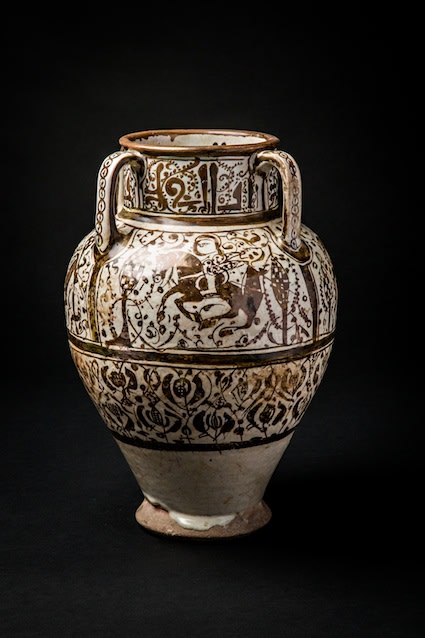Kashan Lustre Painted Amphora, 1170 CE - 1220 CE
Fritware
11.5
LO.1331
The creation of lustreware is a highly sophisticated process and was a closely guarded secret during the heyday of its production. The technique seems to have been invented in Egypt...
The creation of lustreware is a highly sophisticated process and was a closely guarded secret during the heyday of its production. The technique seems to have been invented in Egypt during the 8th century and in the beginning was exclussively employed on glass. It was in 9th century Iraq during the Abbasid caliphate where potters actually first began to experiment with lustre. Lustre is a metal film (usually gold, silver or copper) which is fused onto the surface of a fired glaze, producing the iridescent glow of metal. The metal sulphates are mixed with ocher and painted onto the vessel. It then has to be fired for a second time at a very precise lower temperature and in a kiln which excludes oxygen; the resulting vessel is afterwards burnished in order to bring out the shine. The fact that lustre is fused onto, rather than into the glaze, makes it vulnerable to abrasion. As Islamic prescriptions forbade the use of precious metals, namely gold and silver, for the making of vessels, lustered ceramics did not fall under this ban and were much valued for their glimmering surfaces, which were imitating costlier prototypes. One contemporary, Abu’l Qasim, described lusterware as ‘reflecting like red gold and shining like the light of the sun.’ From the late 10th century, Fatimid Egypt overtook Iraq in the quality of its lusterware. The highest quality works, however, were produced in the small town of Kashan between the late 12th and the mid 14th century.
The Mongol invasions in the 1200s do not seem to have had any detrimental effect on the pottery workshops. Kashan wares were much sought after by discerning patrons, who often commissioned from them enormous quantities of tiles for large-scale architectural projects as well a huge range of vessels. The neatly separated neck of the amphora bears inscriptions on both the exterior and the interior, possibly conferring blessings on the owner of the vessel. Four short handles, decorated by a delicate peacock-eye motif in vertical row, stem below the projecting rim, connecting it to the sloping shoulder. The top tier around the body features four panels containing mounted horsemen, framed on both sides by a checker-pattern tree. This was a characteristic Kashan motif. The horses display an incredible sense of movement and the style recalls that of miniature painting. The lower tier is filled with a scrolling foliate design, featuring small birds nestling in its midst. The decoration is a hallmark of the miniature style painted on white background. Such jars were principally used as storage vessels for grains or liquids but it is unlikely that an item of such quality would have been used for everyday purposes. This jar is remarkable for excellent condition of the lustre work which retains much of its original brilliance as well as for the quality of its decoration.
The Mongol invasions in the 1200s do not seem to have had any detrimental effect on the pottery workshops. Kashan wares were much sought after by discerning patrons, who often commissioned from them enormous quantities of tiles for large-scale architectural projects as well a huge range of vessels. The neatly separated neck of the amphora bears inscriptions on both the exterior and the interior, possibly conferring blessings on the owner of the vessel. Four short handles, decorated by a delicate peacock-eye motif in vertical row, stem below the projecting rim, connecting it to the sloping shoulder. The top tier around the body features four panels containing mounted horsemen, framed on both sides by a checker-pattern tree. This was a characteristic Kashan motif. The horses display an incredible sense of movement and the style recalls that of miniature painting. The lower tier is filled with a scrolling foliate design, featuring small birds nestling in its midst. The decoration is a hallmark of the miniature style painted on white background. Such jars were principally used as storage vessels for grains or liquids but it is unlikely that an item of such quality would have been used for everyday purposes. This jar is remarkable for excellent condition of the lustre work which retains much of its original brilliance as well as for the quality of its decoration.
